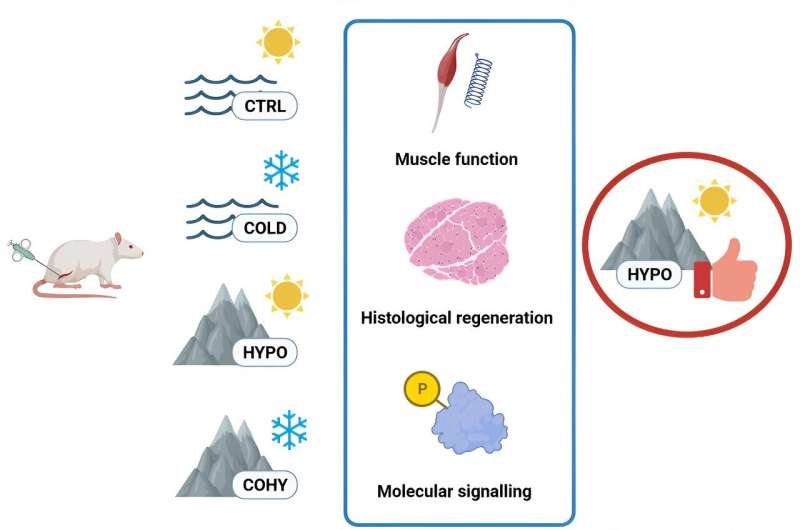This article has been reviewed according to Science X's editorial process and policies. Editors have highlighted the following attributes while ensuring the content's credibility:
fact-checked
trusted source
proofread
New strategy to facilitate muscle regeneration after injury

Muscle injuries are common in the active population, and they cause the majority of player retirements in the world of sports. Depending on the severity, recovery of muscle function is quite slow and may require surgery, medication and rehabilitation. Now, a study led by the University of Barcelona reveals a strategy to improve and accelerate recovery from muscle injuries that has potential application in the sports and health sectors.
This is the first study to provide scientific evidence for faster and more effective recovery from muscle injuries through intermittent exposure to low oxygen availability (hypoxia) in a low-barometric pressure (hypobaric) chamber that simulates high-altitude geographic conditions.
The new approach is important for the recovery of athletes—especially in the competitive elite—but also to mitigate the socio-economic impact of the loss of work productivity caused by these injuries on the active population.
The study, carried out with animal models, has been published in the Journal of Physiology. The authors of the study are the experts Garoa Santoildes, Teresa Pagès, Joan Ramon Torrella and Ginés Viscor, from the Department of Cell Biology, Physiology and Immunology of the UB's Faculty of Biology.
Why does hypoxia help to regenerate injured muscle?
Hypobaric chambers have long been used to improve physical fitness in high-performance sports (mountaineers, climbers, etc.) and in professional sectors (high-altitude mining, astronomical observation, border control). In hypobaric hypoxia conditions, the body is exposed to a low atmospheric pressure environment in which cells take up less oxygen and generate a physiological response. The beneficial effects of intermittent hypoxia exposure on the body are well described, but its potential applications in biomedicine are still being explored.
"The study indicates that any type of muscle injury could recover more quickly with intermittent exposure to hypobaric hypoxia (simulated altitude), but probably also myotendinous injuries could accelerate their recovery," says Professor Viscor, head of the Adaptive Physiology Group: Hypoxia, Exercise and Health at the UB.
In tissues, hypoxia causes local activation of the HIF (hypoxia-induced factor) pathway, which is a sensor of oxygenation levels. "When the amount of oxygen reaching the cells is not sufficient, the HIF protein acts as a switch that activates a series of changes in metabolic pathways to compensate for this deficit," explains Professor Santocildes.
Among other pathways, the HIF protein activates the proliferation of more capillary vessels through endothelial growth factor (VEGF), a process that would bring more growth factors, metabolic substrates and oxygen to the muscle level to support the muscle regeneration process after injury.
As Professor Teresa Pagès explains, "In parallel, the HIF protein would also enhance the synthesis of specific proteins, the activity of some enzymes and the efficiency of the mitochondria, which are the cell organelles that supply energy for cellular functions."
Muscle injuries and therapies: A paradigm shift
In approaching muscle injuries, the classical view of RICE therapy (Rest, Ice, Compression and Elevation) has evolved towards a more holistic and active view, known as PEACE (Protection, Elevation, Avoid NSADs, Compression, Education) and LOVE (Load Management, Optimism, Vascularization, Exercise).
"All this has meant a major paradigm shift in the field of muscle injury recovery," says Professor Torrella. "Exposure to hypobaric hypoxia—the expert continues—is fully compatible with this new paradigm, and could even contribute to improving the effects of emerging therapies to accelerate the recovery of injured muscle."
Therapy based on exposure to low concentrations of oxygen could also help to explore new treatments for pathophysiological injuries. Thus, it would be important to test whether hypoxia can counteract the muscle atrophy typical of sarcopenia—a disease characterized by loss of muscle mass and strength—through the processes involved in muscle recovery (capillary proliferation, more effective oxidative metabolism, etc.).
"In these cases, hypobaric hypoxia intervention would most likely be improved if combined with individualized strength and endurance exercise activities. Even its application in the recovery of patients with persistent COVID-19 syndrome could be improved," the team concludes.
More information: Garoa Santocildes et al, Simulated altitude is medicine: intermittent exposure to hypobaric hypoxia and cold accelerates injured skeletal muscle recovery, The Journal of Physiology (2023). DOI: 10.1113/JP285398


















